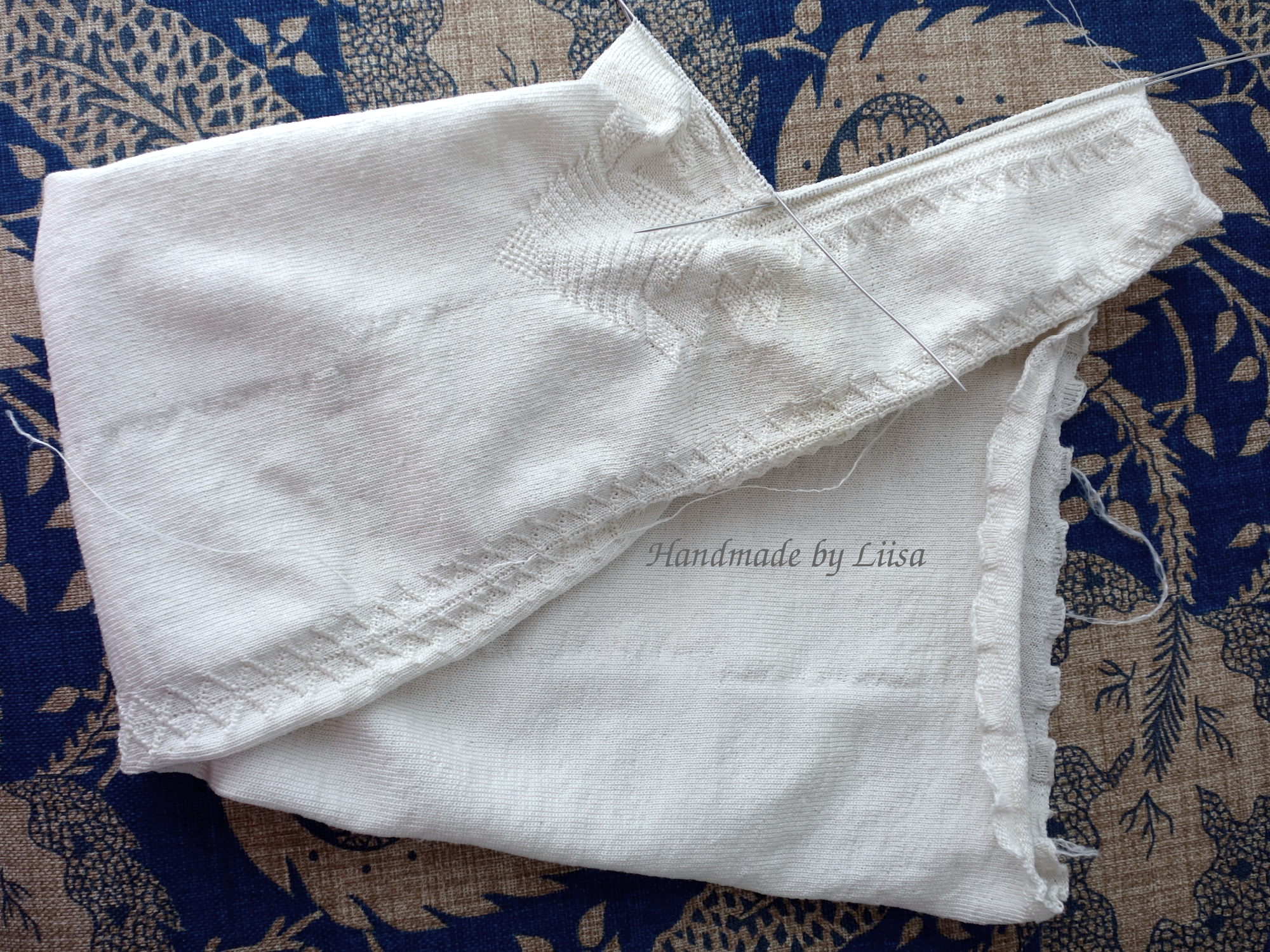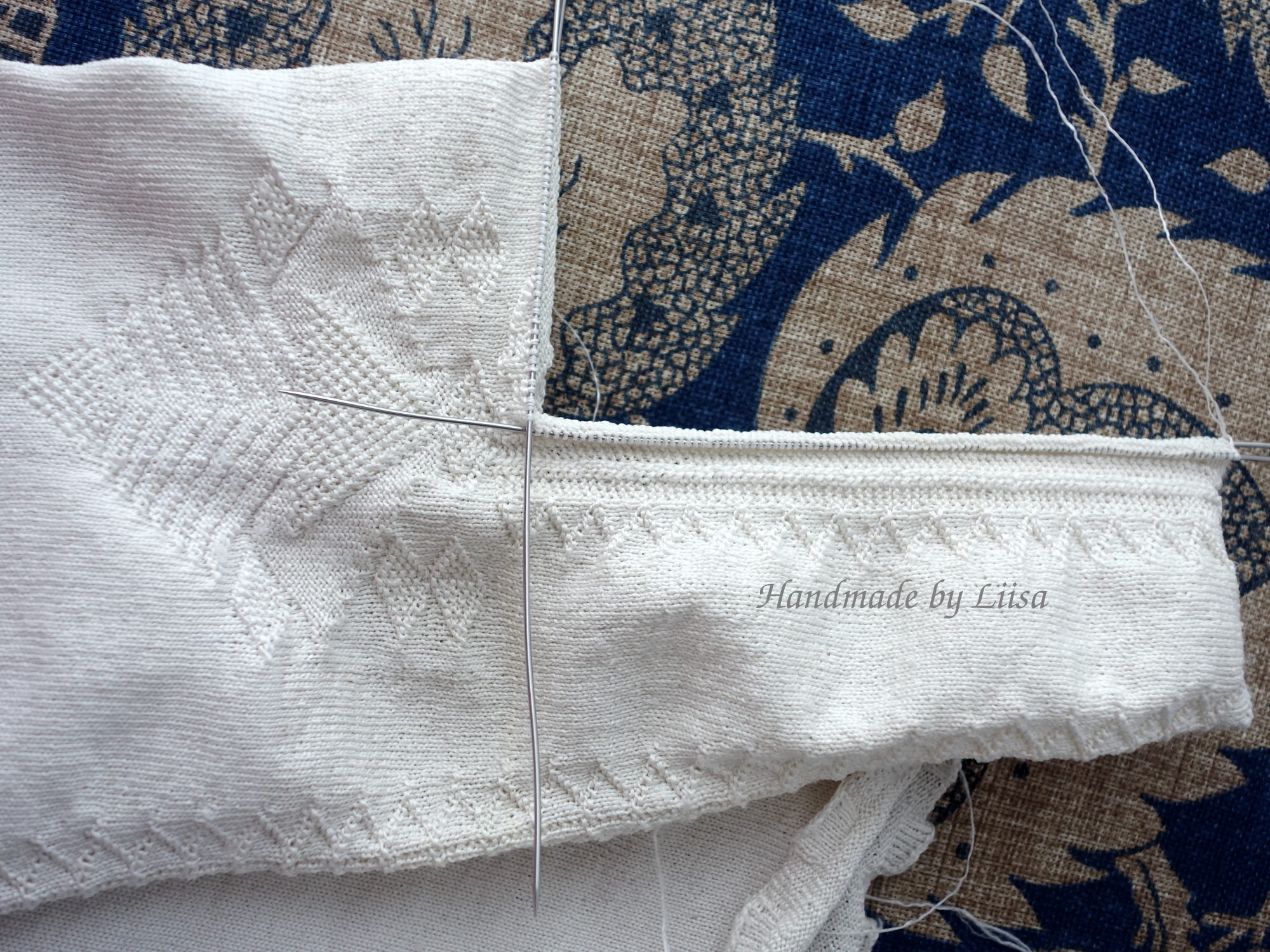
Silkkisukkaprojekti on edennyt parhaimmillaan 20 kerroksen päivävauhtia. Kantalapun valmistuttua kerroksia on kertynyt 734, aikaa kulunut noin 220 tuntia, keskimäärin 2,5 tuntia neulomista päivässä ja vähän vajaa 18 minuuttia per kerros. Sukkaprojektini on osa Aalto-yliopiston tutkimusprojektia josta YLE:n tiedetoimittaja Anniina Wallius kirjoitti pari viikkoa sitten pitkän jutun. Se julkaistiin YLE:n nettisivuilla naistenpäivänä ja kuvitus on minun sukkaprojektistani 🙂 “Silkki ei ollut ylhäisön yksinoikeus”
Sukan teräosalla jatketaan. Ensimmäisten rivien neulominen oli tässäkin taistelua. Silmukat olivat kireällä – ei mitään uutta – mutta sen lisäksi ensimmäisen kerroksen silmukoiden langat olivat suuren työstämisen takia hajonneet ja levinneet niin että niitä oli vaikea hahmottaa. Puikolla silmukat ovat todella tiheässä ja puikot ovat lisäksi hankalasti tiellä kun kahdella puikolla on niin paljon enemmän silmukoita. Siitä huolimatta taidan olla tasaamatta niitä sillä joka kerroksella kiilasta vähenee yksi silmukka. Työ siis helpottuu taas koko ajan loppua kohden!
*
Continuing on with the foot part. The first row especially was agony! The stitches are really tight – nothing new – but also the yarn is split up due to the struggle of getting it onto the needle so it’s hard to see where it starts and where it ends. The stitches are unevenly on the four needles and so compact that it’s hard to move them for fear of dropping them. One stitch is decreased on every row at the beginning of the gusset so the work is getting easier from here to the end!

Vielä 170 kerrosta (noin 10 päivää??) jäljellä.
*
Another 170 rows (ten days??) to go.
Silkkisukkaprojektin aloituksesta kerron tässä postauksessa. Kansalaistiedeprojektin sivuille tästä linkistä.
More about the beginning of my stocking project in this post. More about our citizen science project here.
Update 25.1.2022 a link to all posts related to the Turku silk stocking.
Päivitys 25.1.2022 linkki kaikkiin Turun silkkisukka postauksiin.
Update 24.4.2022 the free pattern for the stockings has been published and can be downloaded from the Refashioning the Renaissance project page here. There is also a new Ravelry page for the stockings.

Uh-huh, mikä projekti. Olen nuo aiemmatkin postaukset lukenut. Tykkään itsekin ohuista puikoista ja ohuesta langasta mutta en nyt sentään ihan näin pientä piperrystä ole tehny. Ja lankakin on noin hankalaa. Mulla oli kaksi vyyhtiä thaimaalaista silkkilankaa mutta todettuani sen aivan liian haasteelliseksi annoin ne kaverille.
Onnea loppumatkalle, kyllä se sujuu, voiton puolella jo olet.
Terveyttä ja tsemppiä!
LikeLike
Kiitos Kristiina 😊 Juu sitkeesti puurretaan loppuun asti! Nyt on hyvin aikaa käsitöillekin… Terveyttä ja reipasta kevättä myös sinne ja kaikille lukijoilleni ☀️🌱🌺
LikeLike
[…] Update 29.3. of how the stocking is taking shape. […]
LikeLike
Would It be possible to get a copy of the pattern from you? I would like to try this, too.
LikeLike
Thank you for your interest 🙂 I’m afraid the pattern has been written only in Finnish for the moment. The research group is planning to publish it, possibly next autumn when they will – hopefully – be able to hold the conference that was originally intended to happen last September. I expect that the pattern will also be translated so I’ll try to remember to keep you posted when it’s available. Liisa
LikeLike
Hello again! I’m not sure you will get this, but I’d like to inform you that the pattern has been released and is available through the link below. There’s a Ravelry page that has been established for the Turku stocking too, which you’ll fin here: https://www.ravelry.com/patterns/library/turku-stockings
Happy knitting!!
https://refashioningrenaissance.eu/knitted-woollen-and-silk-stockings/
LikeLike
Thank you so much. You must have been reading my mind as I was just thinking about this again.
Stephanie Maskell
>
LikeLiked by 1 person
[…] Silk stocking continued (my notes on what it was like to knit with silk and tiny needles). […]
LikeLike
I was thinking about some of your comments on the Fashioning the Renaissance (?) webpage regarding light and vision for fine work like these stockings. I wouldn’t even know where to begin to find the sources to expand on my observations, but I’ll offer them up as lived experience.
I am extremely short-sighted, and always have been. The trait is apparently passed down in my family on the Danish side, and always in family with blue eyes. I’m far from the “most blind” of my blue-eyed cousins, but I am extremely short-sighted all the same. I also have a preference for low light, certainly less bright than most people. I don’t know if that tracks with my myopia, my blue eyes or none of it, considering my equally myopic, blue-eyed mother prefers much brighter light.
In any case, I find my close vision is most accurate without glasses. I have tried various types of reading glasses, only to pull them off and bring the object of my interest quite close to my face. Granted, that distance has increased over the last 20 years, but that only means that I see fine details best at 8 to 12 cm instead of 2 to 4 cm from the end of my nose. I wonder if people with poor distance vision like me and excellent close vision (I can still easily work counted thread work on cloth with >16 threads per cm) were the people who did most of the fine work in previous centuries.
I also would venture that people like me with a preference for low light had an advantage when doing fine needlework, because they could tolerate the shorter days and darker skies in the Northern Hemisphere, and because they could still be productive with nothing more than light from a window, a fire, a candle or a lamp in an era before electricity.
I doubt there is a way to go beyond speculation here, but I think it bears consideration.
LikeLike
Hi Lisa! Thank you for your long and interesting message and your interest in my work.
You certainly would have been the perfect knitter or lace maker in the olden times! Perhaps your ancestors in Denmark were? And you’ve picked the perfect pass time too with counted thread work. This was certainly something I gave a lot of thought to while knitting with my tiny needles in the winter time. I think that my normal reading glasses went from +1,5 to +2 during my project but that might be just age!
Just passed the spring equinox so it’s getting lighter fast ☀🌱🌺😎
LikeLike